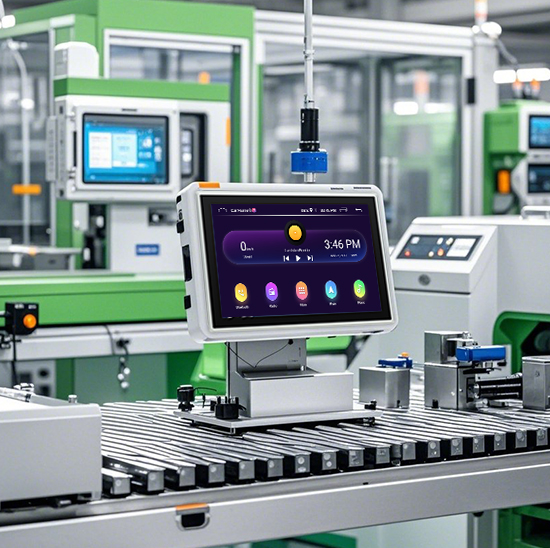في العمليات الصناعية الحرجة - حيث يمكن للحظة واحدة من التوقف أن تسبب خسائر فادحة (في أمان, ربح, أو الامتثال)—شاشات HMI الصناعية هي مركز القيادة لمراقبة العمليات والتحكم فيها. تعمل شاشات HMI الزائدة على تعزيز هذه الموثوقية: إذا فشلت شاشة واحدة, تتولى النسخة الاحتياطية المهمة على الفور, ضمان عدم انقطاع. يستكشف هذا الدليل سبب أهمية التكرار في شاشات HMI الصناعية, الملامح الرئيسية للأنظمة الزائدة عن الحاجة, وكيفية تنفيذها — مساعدة المنشآت الصناعية على حماية العمليات الحيوية.

لماذا يعد التكرار أمرًا بالغ الأهمية لشاشات HMI الصناعية
1. تقليل وقت التوقف عن العمل في العمليات الحرجة
الفشل الفوري: تستخدم شاشات HMI المتكررة تقنية "الاستعداد السريع" - في حالة تعطل الشاشة الرئيسية (بسبب فشل الأجهزة, تحطم البرمجيات, أو فقدان الطاقة), تتولى الشاشة الثانوية التحكم بالمللي ثانية. على سبيل المثال, في نظام التحكم في المفاعل في مصنع كيميائي, وهذا يمنع ارتفاع الضغط غير المراقب أو انخفاض درجة الحرارة أثناء انقطاع واجهة HMI.
الامتثال لمعايير السلامة: الصناعات مثل النفط & غاز, المستحضرات الصيدلانية, ويجب أن تستوفي الطاقة النووية المعايير (على سبيل المثال, اللجنة الانتخابية المستقلة 61508, ايزو 26262) التي تفرض التكرار للأنظمة الحيوية للسلامة. تساعد شاشات HMI الزائدة على تلبية هذه المتطلبات.
2. الحماية من نقاط الفشل الفردية
التكرار المكون: ما وراء الشاشات المزدوجة, غالبًا ما تشتمل الأنظمة الزائدة عن الحاجة على مصادر طاقة احتياطية, بطاقات الشبكة, والمعالجات. وهذا يعني فشل في مكون واحد (على سبيل المثال, مصدر طاقة معيب في واجهة HMI الأساسية) لن يؤدي إلى إزالة واجهة المراقبة بأكملها.
سلامة البيانات: تعمل أجهزة HMI الزائدة عن الحاجة على مزامنة البيانات في الوقت الفعلي, وبالتالي فإن الشاشة الثانوية تحتوي دائمًا على أحدث بيانات العملية (على سبيل المثال, مواقف الصمام, مستويات الخزان). في حالة حدوث فشل, لا يرى المشغلون أي فجوات في المعلومات.
3. تعزيز الاستمرارية التشغيلية
الصيانة المخططة دون توقف: أثناء صيانة HMI المجدولة, تظل الشاشة الثانوية نشطة — مما يسمح بتشغيل العمليات أثناء صيانة الوحدة الأساسية.
مرونة المراقبة عن بعد: للمرافق التي تستخدم الوصول إلى HMI عن بعد (عبر أنظمة SCADA), يضمن التكرار أن المشغلين لا يزال بإمكانهم عرض العمليات والتحكم فيها حتى في حالة فشل أحد أجهزة HMI المتصلة بالشبكة.
الميزات الرئيسية لشاشات HMI الصناعية الزائدة عن الحاجة
1. تصميم تكرار الأجهزة
وحدات العرض المزدوجة: شاشتين HMI متطابقتين (الابتدائي والثانوي) تم تثبيتها, غالبًا في حاويات جنبًا إلى جنب أو في إعدادات التثبيت الزائدة عن الحاجة.
وحدات الإدخال/الإخراج الزائدة: وحدات الإدخال/الإخراج (التي تربط HMI بأجهزة الاستشعار/المحركات) مكررة, لذا فإن الفشل في وحدة واحدة لا يؤدي إلى قطع تدفق البيانات.
المزامنة التلقائية: يعكس HMI الثانوي بشكل مستمر التكوين الأساسي, البرامج الثابتة, والبيانات - مما يضمن أن كلا الشاشتين تعملان دائمًا على قدم وساق.
2. برنامج لتجاوز الفشل السلس
منطق تجاوز الفشل: يكتشف البرنامج المضمن حالات الفشل (على سبيل المثال, فقدان الاتصال مع PLC, تعتيم الشاشة) ويطلق HMI الثانوي لتولي المسؤولية.
أدوات إدارة التكرار: تسمح لوحات معلومات البرامج للمشغلين بمراقبة صحة كلا الجهازين (على سبيل المثال, "HMI الأساسي: متصل, HMI الثانوي: تعليق") وتسجيل أحداث تجاوز الفشل لاستكشاف الأخطاء وإصلاحها.
3. اتصال قوي
مسارات الشبكة الزائدة عن الحاجة: تتصل أجهزة HMI بأنظمة التحكم عبر منافذ Ethernet المزدوجة أو اتصالات ناقل المجال المتكررة (على سبيل المثال, بروفيبوس, مودبوس). إذا فشل ارتباط شبكة واحدة, والآخر يحافظ على تدفق البيانات.
دعم بروتوكول واسع: تعمل أجهزة HMI الزائدة عن الحاجة مع بروتوكولات صناعية متعددة (إيثرنت/IP, بروفينت, مودبوس تكب) للتكامل مع PLCs وأجهزة الاستشعار المتنوعة.
تنفيذ شاشات HMI الصناعية الزائدة عن الحاجة
1. تقييم أهمية العملية
تحديد العمليات الحرجة: ركز على التكرار على العمليات التي يعرض فيها التوقف عن العمل السلامة للخطر, الغرامات التنظيمية, أو خسارة كبيرة في الإيرادات (على سبيل المثال, عمود التقطير في المصفاة, نظام الترشيح لمحطة معالجة المياه).
تحديد مستوى التكرار: اختر "الاستعداد السريع" (الفشل الفوري) للعمليات الأكثر أهمية; "الاستعداد الدافئ" (يتم تشغيل واجهة HMI الثانوية بسرعة بعد حدوث فشل) للعمليات الأقل أهمية لتحقيق التوازن بين التكلفة والموثوقية.
2. حدد الأجهزة والبرامج المتوافقة
توافق بائع HMI: تأكد من العلامة التجارية HMI (على سبيل المثال, سيمنز, روكويل, شنايدر) توفر أنظمة زائدة عن الحاجة وأن تكون أجهزة PLC/أجهزة الاستشعار الخاصة بك متوافقة.
ترخيص البرمجيات: التحقق من ميزات التكرار (على سبيل المثال, إدارة الفشل) تم تضمينها في ترخيص برنامج HMI الخاص بك، حيث يطلب بعض البائعين تراخيص متميزة للتكرار.
3. خطة التثبيت والاختبار
الإعداد الجسدي: قم بتثبيت أجهزة HMI الأساسية والثانوية في مواقع يسهل الوصول إليها (للصيانة) وضمان التبريد / الطاقة الكافية (إمدادات الطاقة الزائدة أمر لا بد منه).
اختبار تجاوز الفشل: قم باختبار تجاوز الفشل بشكل منتظم من خلال محاكاة حالات فشل واجهة HMI الأولية (على سبيل المثال, فصل الطاقة, تعطيل الشبكة). تحقق من تولي واجهة HMI الثانوية المسؤولية دون فقدان البيانات أو تعطيل العملية.
الأسئلة الشائعة حول شاشات HMI الصناعية الزائدة عن الحاجة
س 1: ما مدى زيادة التكرار في تكلفة شاشات HMI الصناعية؟?
A1: عادةً ما يضيف التكرار ما بين 30 إلى 50% إلى التكلفة الأولية, ولكن يتم تعويض ذلك عن طريق تجنب خسائر التوقف عن العمل. للعمليات الحرجة, عائد الاستثمار (العائد على الاستثمار) غالبا ما يكون سريعا.
Q2: هل يمكنني إضافة التكرار إلى موجود (غير زائدة عن الحاجة) أنظمة HMI?
A2: في كثير من الحالات, نعم - يقدم البائعون وحدات زائدة عن الحاجة أو ترقيات للبرامج قابلة للتعديل. لكن, يعتمد التوافق على عمر وطراز HMI.
س 3: كيف يمكنني مراقبة صحة أجهزة HMI الزائدة عن الحاجة?
A3: تشتمل معظم الأنظمة الزائدة على لوحات المعلومات أو مؤشرات LED على أجهزة HMI التي تعرض الحالة "الأساسية/الثانوية". يتكامل البعض أيضًا مع SCADA أو CMMS (أنظمة إدارة الصيانة المحوسبة) للمراقبة عن بعد.
س 4: ما هو العمر الافتراضي لشاشات HMI الصناعية الزائدة عن الحاجة؟?
A4: مع الصيانة المناسبة, 7-10 سنوات - على غرار أجهزة HMI غير الزائدة عن الحاجة, حيث يركز التكرار على تجاوز الفشل, عدم إطالة عمر المكونات الفردية.
خاتمة
تعد شاشات HMI الصناعية الزائدة عن الحاجة بمثابة حجر الزاوية في الموثوقية للعمليات الهامة, القضاء على نقاط الفشل الفردية وضمان التشغيل دون انقطاع. من خلال الاستثمار في التكرار, المنشآت الصناعية تحمي السلامة, الامتثال للمعايير, والحفاظ على الإنتاجية.
إذا كنت مستعدًا لتطبيق شاشات HMI الزائدة عن الحاجة (أو تحتاج إلى مساعدة في تقييم احتياجات التكرار الخاصة بالعملية الخاصة بك), املأ النموذج على موقعنا. سيقوم خبراء الأتمتة الصناعية لدينا بتحليل الإعداد الخاص بك والتوصية بحلول مخصصة لتحقيق أقصى قدر من وقت التشغيل.

